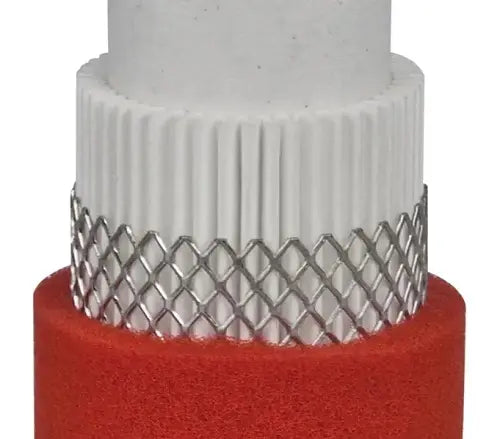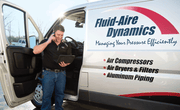Compressed air filtration is an important part of your compressed air system. Installing the right type of air compressor filters and maintaining them regularly will ensure a consistent supply of clean air to your operations and reduce pressure drop. An industrial air compressor will usually require intake filters to remove contaminants from incoming air and inline filtration to remove particulates, oil carryover, remaining moisture, and odors from the discharged compressed air. If you have an oil-flooded rotary screw, rotary vane or reciprocating compressor, you’ll likely need multiple stages of compressed air filtration. Follow these guidelines to select the best air compressor filters for your system.
Why Do You Need Compressed Air Filtration?
Why do I need a filter on my air compressor? Contaminants in your air supply – including dirt and dry particulates, moisture, and oil carryover – can cause big problems for production processes and your air distribution system. While air purity is more important for some applications than others, clean, dry air is a benefit for most compressed air applications. Filtration is also a critical aspect of maintaining the efficiency and longevity of your compressed air systems. Without proper compressed air filtration, contaminants that enter the air supply through intake air or from inside the system will end up in the distribution system and ultimately at the point of use.
Sources of Air Contamination
Where do these contaminants come from? Some contamination comes in with the intake air. If the compressor is located in an environment with a lot of airborne particulate, that will impact the cleanliness of your compressed air. In industrial applications, dust and fumes from production processes can contaminate compressed air. Outside air can be problematic, too — especially in the spring, when pollen counts rise, and in the fall, when mold and leaf dust are in the air. If the compressor is located outside or factory doors are kept open, these seasonal considerations will impact compressed air cleanliness and compressor performance.
Other contaminants are generated within the air compressor itself. Compressing air generates moisture, which must be removed through air treatment and filtration. In an oil-flooded industrial compressor, such as a rotary screw, some of the oil also enters the air stream as oil carryover. Fine particulate and rust particles can also be created by the compressor motor or inside the system.
Problems Caused by Compressed Air Contamination
Contamination in compressed air can cause significant problems for tools and equipment, product quality, worker health and system efficiency. Air compressor air filters remove contaminants from intake air or already compressed air to prevent these problems. A good air compressor filter can help you avoid issues like these below.
- Equipment damage: Contaminants in the compressed air can cause abrasion, corrosion, or blockages in the system, leading to premature wear and tear or failure of equipment components.
- Reduced efficiency: Contaminated compressed air can result in inefficient performance of pneumatic tools and machinery, increasing energy consumption and operational costs.
- Product contamination: In industries like food processing, pharmaceuticals, or electronics manufacturing, contaminated compressed air can lead to product contamination, affecting the quality and safety of the final product.
- Increased maintenance costs: The presence of contaminants in compressed air can necessitate more frequent maintenance and cleaning of equipment, driving up maintenance costs.
- Downtime: Improper filtration can lead to equipment breakdowns and production delays, negatively impacting productivity and profitability.
- Health and safety risks: Compressed air contaminated with oil, water, or particulates can pose health and safety risks to workers, potentially leading to respiratory issues or other illnesses.
Types of Compressed Air Contamination
Compressed air can contain various contaminants that can affect the performance and reliability of the system, as well as the quality of the air for specific applications. These contaminants can originate from the ambient air, the compression process, or the compressor's components. To ensure the efficient and safe operation of compressed air systems, it is essential to understand the different types of contaminants and implement appropriate filtration solutions.
Dry Particulate

Dry particulate contaminants consist of solid particles such as dust, dirt and rust that can enter the compressed air system from the ambient air or form during the compression process. These particles can cause abrasion, clogging, or blockages in the system, leading to reduced efficiency and equipment damage. Proper intake filters and inline particulate filters can help remove these solid contaminants to ensure clean and efficient compressed air.
Oil Carryover
Oil carryover is the presence of oil aerosols or vapors in compressed air, which is typically caused by the lubrication process in oil-lubricated compressors. These oil contaminants can lead to product contamination in sensitive applications and affect the performance of pneumatic tools. To address oil carryover, coalescing filters and activated carbon filters can be used to remove oil aerosols and vapors from the compressed air.
Moisture
Moisture is a common contaminant in compressed air systems, as the compression process causes the water vapor in the ambient air to condense into liquid water. If not properly removed, moisture can cause corrosion, bacterial growth, and freezing in low-temperature applications, leading to equipment damage and reduced efficiency. In addition to compressed air filtration, aftercoolers and air dryers can be used to remove excess liquid from the air supply. In-line filtration is typically the last line of defense against moisture once other air treatment methods have been applied.
Microorganisms

Microorganisms such as bacteria, mold, and fungi can enter the compressed air system from the ambient air or grow in the presence of moisture. These biological contaminants can pose health risks to workers and lead to product contamination in industries like food processing and pharmaceuticals. To mitigate the risks associated with microorganisms, sterile filters and proper system maintenance, including regular cleaning and inspection, can help maintain the air quality and prevent microbial growth.
What Kinds of Filters Are Used in an Air Compressor?

Compressed air filtration starts at the air intake and carries through the entire system to ensure a consistent supply of clean, pure air. Your air compression system may require more than one type of filter; different types of air compressor filters have different jobs. Filters commonly used for air compression include:
- Intake filters
- Inline filters
- Oil filters
Intake filters are a type of particulate filter positioned at the air intake to filter contaminants out of atmospheric air before it enters the compressor. These filters are usually rated to capture coarse particulates such as dust and pollen. An intake filter generally removes dry particulates only.
Inline filters (air line filters) are positioned after the compressor to provide additional filtration for already compressed air. A standard inline particulate filter will remove dry particulate down to 1 micron in size. However, they will not remove oil mists. Oil-lubricated air compressors (such as rotary screw air compressors) will need an inline filter rated for both particulate and oil, such as a coalescing air filter. Inline filters may be placed directly after the air compressor; finer filters should be placed after the compressed air dryers or immediately before the end application.

Oil filters are used to remove particulate from liquid oil in oil-lubricated air compressors (such as rotary screw air compressors). An oil filter is needed to extend the life of the compressor oil and ensure adequate lubrication.
Choosing the Best Air Compressor Filter for Your Needs

There are several factors to consider when choosing filtration for your compressed air system. High-quality filters will reduce maintenance requirements, minimize pressure drop, improve energy efficiency and ensure a consistent supply of clean, dry air.
Filter Quality
Installing a high-quality filter may cost a bit more up front, but it will pay off in the end. High-quality filters will last longer and require less maintenance. They also are less likely to have failures that allow contaminants to escape past the filter, ensuring that air quality will meet the requirements of your application. Always purchase compressed air filters from a trusted and reliable manufacturer to safeguard your equipment and processes.
Filtration Efficiency
There are two elements to filtration efficiency for an oil-lubricated air compressor: particulate filtration efficiency (measured in microns) and oil carryover (measured in parts per million, or PPM).
Dry contaminants in compressed air are measured in micron size. A micron is one-millionth of a meter, or 0.001 mm. The human eye can see particles as small as 50-60 microns, or a bit less than the diameter of a human hair. Contaminants in compressed air systems can be much smaller than this. About 80% of industrial contaminants are in the fine or ultra-fine range.
- Fine particles are defined as less than 2.5 microns.
- Ultrafine particles are defined as less than 0.1 microns.
Filtration efficiency for dry particulate (micron rating) is measured by the size of the particle the filter can capture. A basic intake filter may remove particulates in the 30-40 micron range and above — enough to take out most pollen and coarse particulates, but not finer particles. Advanced dry particulate filters (such as HEPA filters) and coalescing oil filters can remove particles down to 0.01 microns. Filter efficiency is expressed in a percentage; the higher the percentage of the particle size rating, the more particles they will remove. Oil removal of a given filter is rated in remaining oil going downstream measured in PPM, or parts per million.
Pressure Drop
When selecting filters for your compressor system, there's often a trade-off between pressure drop and filtration efficiency. Pressure drop is defined as the difference in air pressure (PSI) measured before and after the filter; higher pressure drop indicates that the system is working harder to push air through the filter. High filtration efficiency typically requires a denser filter media or smaller pore size, which can increase pressure drop across the filter and thus the energy requirements for the system. Striking the right balance between pressure drop and filtration efficiency is essential to maintain clean compressed air while minimizing energy consumption and operational costs. Select a filter that provides the necessary filtration efficiency while minimizing pressure drop to ensure optimal system performance and energy efficiency.

Filter Media
The filter media is the material used in the filter element to capture and remove contaminants. Common filter media materials include paper, polyester, cellulose, glass fibers, stainless steel, or synthetic materials. Each material has unique properties that affect filtration efficiency, pressure drop, and service life. Choose a filter media that provides the desired filtration performance while considering factors like operating environment, temperature, and humidity.
Flow Rate
The flow rate refers to the volume of air that can pass through the filter per unit of time, typically measured in cubic feet per minute (CFM) or liters per second (L/s). Choose a filter with a flow rate capacity that matches or exceeds your air compressor's output to ensure proper filtration without causing restrictions or reducing efficiency.
Service Life
Service life is the expected operating time before the filter needs to be replaced or serviced. Longer service life can reduce maintenance costs and downtime. When selecting a filter, consider factors like the operating environment and contaminant levels, and choose a filter with a service life that meets your maintenance schedule and budget.
Types of Air Compressor Filters
The combination of air compressor filters you need will depend on the type of air compressor you have, the purity of air you require, and what you are trying to filter out.
- Dry particulate filters, as their name implies, remove only dry dust and particulate.
- Coalescing filters remove both particulate and aerosolized liquids.
- Adsorption filters remove gases, vapors and smell.
Dry Particulate Filters
Dry particulate filters remove dry particulate from the airstream. They may be compressor intake filters or inline compressor filters (air line filters). Dirt particles are trapped by the filter media through direct interception, inertial impact or diffusion. Large particles are directly blocked by the fibers in the filter media. Smaller particles are intercepted as they move erratically through the media via Brownian motion (diffusion). These particles are held in the media through electrostatic attraction.
Coalescing Inline Filter

A coalescing filter is another type of inline air compressor filter. An oil coalescing air filter is a type of air line filter that removes both oil mists or oil vapors and dry particulates. A coalescing filter works by trapping mists and aerosols in layers of fine mesh. Aerosolized oil particles and water droplets collect on the surface of filter media and coalesce into larger and larger droplets until they are heavy enough to fall. Liquid is collected at the bottom of the filter and drained away. Fine particulates fall out with the liquid, while coarser particles remain trapped in the filter media.
Coalescing filters provide superior filtration for both particulates and aerosols. They can remove aerosolized droplets and particles down to 0.01 microns and remaining oil to .008 PPM or lower. They may be used alone or in combination with other filters.
Adsorption Filters
An adsorption air compressor filter is used to trap vapors, gaseous contaminants, chemical fumes and odors. These filters are used for high-purity applications that require the removal of trace gases and vapors along with sub-micron particulates. Activated carbon is the most common material used for adsorption.
In adsorption technologies, molecules of a gas, liquid or dissolved solid adhere to the surface of a material inside the filter cartridge. Adsorptive materials like activated carbon have millions of tiny micropores, which increase the available surface area for adhesion. Molecules bond to these surfaces and are trapped within the micropores.
An activated carbon filter can remove unwanted vapors, gases and noxious odors from compressed air. It should be used in combination with a compressed air dryer (either a refrigerated dryer or adsorption dryer) and a coalescing filter to remove oil mists and dry particulate from the air before it hits the adsorption filter.
Air Compressor Oil Filters
Oil filters are used for oil-lubricated industrial air compressors, such as oil-injected rotary screw compressors. They remove dirt, rust and other coarse contaminants from liquid oil as it circulates through the compressor. This protects the compressor from wear and tear on bearings and other lubricated parts. An air compressor oil filter is similar to the oil filter you might find on your car or lawnmower.
The air compressor oil filter has a few important characteristics.
- A bypass valve, which will supply oil to the compressor if the filter is clogged (because dirty oil is better than no oil!).
- A high-pressure housing and special seals to withstand fluctuating pressures in compressed air applications.
Factors to Consider When Choosing an Air Compressor Filter
When choosing an air compressor filter, several factors need to be considered to ensure the appropriate level of air quality and the efficient operation of the compressed air system. Here are some key factors to consider.
Air Quality Standards
Air purity requirements will have a big impact on air compressor air filter selection. Most compressed air applications benefit from clean, dry air. But how clean compressed air needs to be depends on how it is being used. Air used to inflate tires can tolerate quite a bit of contamination, while air used in medical applications or food and pharmaceutical production will require ultraclean air.
- For pneumatic systems, basic air filters with efficiencies between 0.3 and 1 microns are generally sufficient.
- Paint lines and similar applications may require filtration efficiency down to 0.1 microns with low oil carryover.
- Medical, food processing and pharmaceutical applications require ultraclean air, down to 0.01 micron, along with removal of all vapors, aerosols and gases.
For applications where air purity is essential, it makes sense to conduct compressed air testing to ensure safety and compliance.
Type of Compressor
The type of compressor will also influence filter selection for your compressed air system. In all cases, it is critical to use a filter of the right size and type for the compressor, as outlined in the owner’s manual. One of the biggest factors: is your compressor an oil-flooded or oil-free air compressor?
- Oil-free air compressors will not, of course, require oil filters. Oil carryover is not an issue with these compressors, either, so coalescing filters to remove oil droplets from the air may not be needed (unless they are used for moisture removal). Oil-free compressors are generally used in environments where a very high degree of purity is required, so dry filters with very high filtration efficiency may be used along with activated carbon filters to remove trace vapors and gases.
- An oil-flooded compressor, on the other hand, will generally require appropriate filtration for oil removal, such as a coalescing filter. With the right filtration strategy, oil-flooded compressors can often match oil-free compressors in terms of air purity.
Operating Environment
The operating environment, including temperature, humidity, and the presence of airborne contaminants, can affect the performance of compressed air filters. High humidity levels can increase the moisture content in the compressed air, requiring the use of moisture separators or dryers. Environments with high levels of dust or airborne particles may necessitate more frequent filter changes or the use of pre-filters to extend the life of the primary filters.
Frequency of Use
The frequency of use and the overall demand for compressed air within the facility will influence the choice of filtration system. Facilities with high air demand and continuous operation may require more robust filtration solutions, including higher-capacity filters or filters designed for continuous operation. Automatic drains can reduce maintenance requirements for filters in high-production environments. In contrast, facilities with lower air demand or intermittent use may opt for more economical filtration solutions.
Maintaining Air Compressor Filters

How often should air compressor filters be changed? It is important to maintain air compressor filters for optimal performance of your compressed air system. Changing and maintaining air compressor filters is an essential part of overall air compressor maintenance.
Clogged filters will quickly sap the energy. Every 2 PSIG in pressure drop across the air line filter adds 1% to the cost of running the air compressor; many compressors are running at higher pressures than necessary to compensate for pressure drop across the filter cartridge.
Filters also lose their filtration efficiency over time, especially if you have abrasive contaminants in the airstream. Micro-tears and holes in filter media will allow contaminants to make it past the filter, where they can end up in the air supply; this is also true with the oil separator in the air compressor.
How Often Do You Need to Change the Filter on an Air Compressor?
The maintenance schedule will depend on your operations (air compressor runtime) and the overall cleanliness of the environment in which the compressor operates. Intake filters and air line filter cartridges will need to be changed much more often for an air compressor running 24/7 in a dusty room than for a compressor operating intermittently in a relatively clean space.
- Monitor intake air filters and change them when they appear dirty or worn. Intake filters are typically changed after 2,000 hours of use, but the filters will need to be changed more frequently if your environment is very dusty.
- Inline filters should be changed at least once a year or every 8,000 hours of operation. Monitor pressure drop (the differential pressure before and after the filter) to determine filter loading. If you see excessive pressure drop before 8,000 hours of operation, your air line filter cartridges need to be changed more frequently. (Check your service manual for your specific inline filter model.)
- Compressor oil filters should be changed every 2,000 hours at minimum or more often if the oil appears dirty or degraded. At least once a year, oil should be completely drained and flushed. Always replace your oil filter after flushing.
Proper air compressor filter maintenance will go a long way toward preventing problems with your air compressor. Clean air and oil filters will save energy, reduce wear and tear on the air end and extend the life of your air compressor.
Air Compressor Filters from Fluid-Aire Dynamics
Fluid-Aire Dynamics offers a wide selection of high-quality air compressor filters for rotary screw, rotary vane, and reciprocating air compressors, including inline filters, intake filters, and oil filters. Contact the Aire experts at Fluid-Aire Dynamics to find the best filters for your air compressor and ensure optimal performance, efficiency, and longevity for your system.






